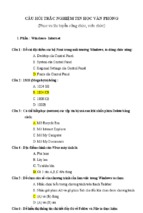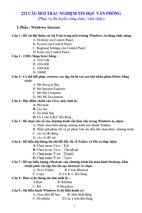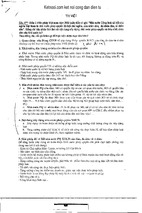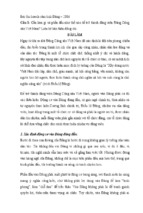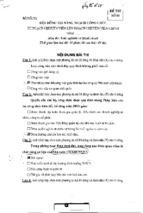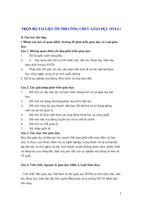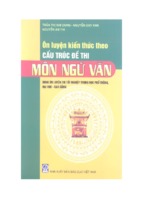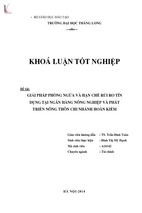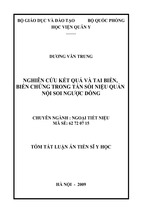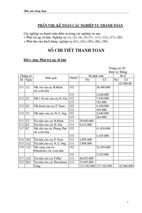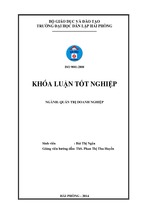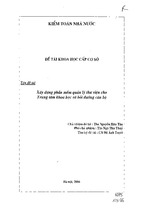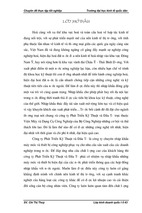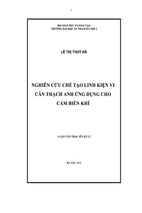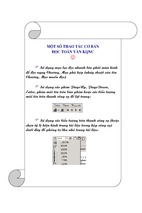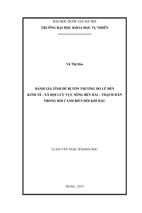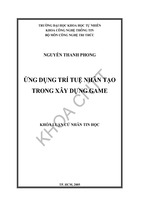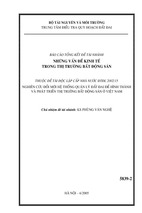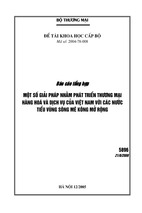The Use of Hyper-Reference and Conventional Dictionaries (Ronald Aust, Mary Jane Kelley, Warren Roby)
The Use of Hyper-Reference
and Conventional Dictionaries
[ ] Ronald Aust
Mary Jane Kelley
Warren Roby
A hyper-reference is an online electronic aid
that provides immediate access to adjunct information with a direct-return path to the
target information. Eighty undergraduateforeign language learners participated in a comparison of hyper-reference and conventional
paper dictionary use on the measures of consultation frequency, study time, efficiency,
and comprehension. Hyper-reference users
consulted over two times as many definitions
as conventional dictionary users. Analyses of
efficiency (consults per minute)found a
higher consultation rate for hyper-r~ference
users than for conventional dictionary users.
The study also compared bilingual (Spanish/English) and monolingual (Spanish~simplified Spanish) dictionary use. Bilingual
dictionary users consulted 25% more definitions than did monolingual dictionary users.
Bilingual dictionary users completed reading
in 20% less time than monolingual dictionary
users. Efficiency was also higher during bilingual dictionary use than during monolingual
dictionary use. Differences in comprehension
were not significant. Directions for further
research and development concerning electronic text and hyper-references are offered.
ETR&D, Vol. 41, NO. 4, pp. 63-73 ISSN 1042-1629
[] A little over a decade ago, personal computing launched a revolution in the way humans
produce and consume information. Word processing exemplifies the production aspect of
this revolution, as it has transcended the traditional typewriter by offering superior capabilities for managing information, facilitating
revisions (Leonardi, 1987), producing professional print quality that increases pride of authorship (Baer, 1988; Kahn, 1987), and easing
access to writing tools such as a thesaurus or
spelling checker (Kasnic & Stefano, 1987). With
the production aspects secured, developers are
now seeking to revolutionize information consumption by advancing key technologies involving information storage, computer
portability, networking, intelligent interfaces,
a n d screen fidelity. As these technical advances mature and as the economical and ecological advantages for conserving paper are
realized, the widespread reading of electronic
text may initiate the next major transition in
the information revolution.
Electronic references that aid in understanding text-- namely dictionaries and glossaries-represent one of the most rapidly
growing forms of electronic text (Weissman,
1988; Wooldridge, 1991). Early proponents of
automated dictionaries (Fox, Bebel, & Parker,
1980; Miller, 1980) recognized that the ability
ETR&D,VoL 41, No. 4
to immediately consult a reference and then
return directly to the main reading passage has
implications for learning. After all, readers are
distracted from the target information when
they locate a paper reference (which is often
across the room), flip through pages, and
struggle with reading the fine print. Users who
would otherwise forgo these lengthy paper
searches may use electronic references frequently because the searches take place in a
matter of seconds and involve less diversion
from the study text. As was true of their paperbased forbears, there are many design issues
for electronic texts and online references.
HYPERTEXT AND
HYPER-REFERENCES
The general term "hypertext" describes an
array of emerging technologies for accessing,
organizing, and relating electronic-based information. Ted Nelson (1981,1982) first used this
term to describe a hypothetical electronic notebook for immediately consulting elaborations
on any word or phrase by simply pointing to
or "clicking" information the user wishes to
learn more about. Advances in computer hardware and in software, such as HyperCard,
protocols for intelligent communication devices (Hill & Yamada, 1993), and pen-based
portable computers, are making hypertext accessible to a much broader range of developers, who in turn are fostering innovative
strategies for applying hypertext to instruction
(Campbell & Goodman, 1987; Halasz, 1987;
Smith & Weiss, 1988).
Some recent hypertext innovations capitalize on the mass storage capacity of videodiscs
and CD-ROM to integrate media in enhanced
i m p l e m e n t a t i o n s k n o w n as h y p e r m e d i a
(Kinzie & Berdel, 1990). A full-fledged
hypermedia environment gives users unlimited access to diverse multimedia knowledge
bases with unrestricted cross-referencing,
Using a hypermedia reference, a learner might
click on the word "whistle" and have the option of hearing either the standard pronunciation or one of several whistle sounds. In
another hypermedia scenario, a user who
clicks on the word "throw" in the text of a story
can view a full-motion video clip depicting
several throwing techniques, then click on a
picture of a baseball to see how it is manufactured, and so on. These systems are very flexible, but hypertext systems that are completely
open can create what Kerr (1986) described as
"wayfinding" problems that cause users to
become lost in hyperspace.
For this study, we chose a hypertext design
that uses an electronic dictionary because the
searching advantages of hypertext adaptations are especially evident with large modular r e f e r e n c e s (Locatis, L e t o u r n e a u , &
Banvard, 1989; Raymond & Tompa, 1988). The
dictionary is also a good reference to study
because it is "the most widespread single language improvement device" (Brumfit, 1985, p.
v.), yet people find it "arduous" to consult
(Keller, 1987, p. 17). The design we chose is a
simple, bidirectional hypertext implementation that limits potential wayfinding confusion. Our electronic book looks similar to an
open paperback, with two pages shown on
each computer screen. The user navigates
through the pages in a linear fashion by clicking on small arrows at the bottom of the screen.
A user who wishes to consult the dictionary
clicks on a word in the text and the definition
for the word appears immediately in a window on the opposing page of the electronic
book. After reading the definition, the user
clicks on the "close" button on the definition
window and the underlying text reappears
(see Figure 1).
We describe this electronic dictionary as a
"hyper-reference" implementation, meaning
an electronic reference aid that offers immediate access to supportive information with a
clear and direct return path to the target information. Although hyper-references do not
offer the unrestricted mobility envisioned both
by early innovators (Bush, 1945; Engelbart &
English, 1968; Nelson, 1981) and more recent
hypertext proponents (McKnight, Dillon, &
Richardson, 1991; Rada, 1991), their ability to
limit wayfinding problems may outweigh alleged advantages of complex hypertext when
the intent is to provide immediate ancillary
support. Moreover, when using hypertext systems that have weak link indicators, "most
65
HYPER-REFERENCES
FIGURE 1 [ ] Electronic Book with Hyper-Reference
i
Gonzdlez
"Nunca m e d o y por vencida"
Comenz6 su lucha temprano,
Los obstaculos no h a n podido
con ella, es m~s, la h a n motivado
a laborar con mayor ahinco.
Primero fue el estudio, luego
largas horas de trabajo -de ir
aprendiendo y mejorando- h a s t a
lograr el objetivo: instalar u n a
pequefia industria. Sin embargo,
al poco tiempo u n incendio
destruy6 todos sus sue~os y
meses delesfqerzo]y dedicaci6n.
Pero e s t e ~ r i m e r gran
tropiezo en su vida empresarial
e~erzo
®
esfuerzo m. effort, exertion;
[valor) courage, bravery;
(~nimo) spirit, heart.
In the above depiction of the electronic book, the user has clicked on the word
"esfuerzo* and the definitionhas appeared in the window on the opposing
page. Thus, the selected word remains visiblein the context of the storywhile
the user reads the definition.The button in the upper rlght-hand corner isused to
close the definitionwindow. Thisfigure shows the bilingual(English)version.A second verSion that provided monolingual (SimplifiedSpanish) definitionswas also
used in the study.
students tend to start from a single organizing
node, examine links from that node and return
immediately to the same node" (Welsh, Murphy, Duffy, & Goodrum, 1993, p. 20).
FOREIGN LANGUAGE
DICTIONARIES
We chose foreign language as the content discipline for investigating the use of references
because foreign language study typically involves considerable dictionary usage, thereby
creating a rich "look-up" environment. Another reason for selecting this content was the
need for additional research concerning dictionary use during foreign language learning.
Although self-report questionnaires offer in-
sights concerning the use of dictionaries
(B6joint, 1981; Coviello, 1987; Galisson, 1983;
Tomaszczyk, 1979), several scholars (Crystal,
1986; Hartmann, 1983, 1987; Ilson, 1985;
Lantolf, Labarca, & den Tuinder, 1985; Zgusta,
1975) have called for empirical evidence to
support opinions concerning when and how
learners make effective use of dictionaries.
Dictionaries designed to support foreign
language learning fall into two primary categories: bilingual dictionaries, which provide
the reference word in the target language and
definitions in the readers' native language
(e.g., Spanish/English), and monolingual dictionaries, which present both the reference
word and simplified definitions in the target
language (e.g., Spanish/simplified-Spanish).
Foreign language learners prefer bilingual dic-
66
ETR&D, Vol.41, No. 4
tionaries (Atkins, 1985; Benoussan, Sim, &
Weiss, 1984). This preference possibly stems
from the desire to gain near-term understanding of the material they are immediately reading, as opposed to the longer-term desire of
mastering a foreign language. However, many
language educators (Snell-Hornby, 1984;
Yorkey, 1970) believe that bilingual dictionaries are counterproductive because they cultivate the erroneous assumption that there is a
one-to-one correspondence between the
words of the two languages. Bland, Nobitt,
Armington, and Gay (1990) refer to this problem as the "naive lexical hypothesis." Moreover, these critics contend that bilingual
dictionaries encourage learners to engage in
surface translating rather than reading and
thinking in the target language.
tionaries, we expected that the combined reading and consultation time would be less when
consulting a bilingual dictionary than when
consulting a monolingual dictionary.
M~HOD
Design
A 2 x 2 design was used in comparing reference media (hyper-referenceand conventional
paper) and dictionary language (bilingual and
monolingual). Comparisons of reference
media were made on four dependent measures: frequency of consultations, reading
time, efficiency, and comprehension.
Subjects
RESEARCHASSUMPTIONS
This study investigated the computer's potential to alter the way information is consumed
by expediting the use of adjunct aids while
reading electronic text. Because hyper-references offer immediate access to supportive information, we expected that the definitions
would be consulted more frequently and that
the combined reading and consultation time
would be less when consulting a hyper-reference
than when consulting a conventional dictionary. The ease of accessing a hyper-reference
and returning to the target text should also
benefit comprehension by enabling learners to
focus on the reading passage. Consequently,
we anticipated that comprehension would be
greater when reading and consulting a hyperreference than when reading the same passage
while consulting a conventional dictionary.
Another interest of this study was to compare bilingual and monolingual dictionaries
across both the hyper-reference and conventional paper conditions on frequency of use
and overall reading time. The preference for
bilingual dictionaries reported in previous
studies was expected to prevail, with the bilingual dictionary being consulted more frequently than the monolingual dictionary.
Because definitions in bilingual dictionaries
tend to be briefer and require less effort to
process than definitions in monolingual dic-
Of the 80 undergraduates who volunteered to
participate in the study, 27 were male and 53
were female. At the time of the study, all subjects were enrolled in sections of a fifth-semester university Spanish course. They reported
an average of 3.3 years of Spanish coursework
before attending the University. The mean
number of university semester hours completed was 67, and the subjects' mean GPAwas
3.16 for all university coursework. Subjects
also reported that they had completed an
average of 11 hours of university Spanish
coursework, with a mean GPA of 3.44.
Materials
The text used in all conditions was a replica of
the 420-word article entitled "Nunca me doy
por vencida" that appeared in the November
21,1989, issue of Rumbo, a Costa Rican magazine. A professor of Spanish judged the article
to be moderately difficult for students in their
fifth semester of Spanish. Results from a cloze
version of the article, completed by 16 fifth-semester students during the pilot phase, supported the professor's judgment. The mean
restoration rate on the cloze analysis (42.3%)
approached the range (44-53%) that serves as
a practical guide in determining whether a
passage is above frustration level while being
67
HYPER-REFERENCES
challenging enough for instructional use (HaskeU, 1975).
We prepared replicas of the article for four
conditions:
A. an electronic article with a bilingual hyperreference dictionary based on the American
Heritage Larousse Spanish Dictionary
B. an electronic article with a monolingual
hyper-reference dictionary based on the
Diccionario Larousse del espafiol moderno
C. a paper article with a bilingual paper dictionary
D. a paper article with a monolingual paper
dictionary.
For the two hyper-reference conditions (A
and B), we, transcribed the Rumbo article to a
five-page prototypic electronic book using
HyperCard software. Readers navigated
through this electronic article by clicking forward and back buttons at the bottom of each
page. They could consult definitions for any
word in the electronic book, and after clicking
on a word, the definition window immediately
appeared on the page opposite from the
selected word. This opposing-page feature
allowed learners to see the word in its context
while reading the definition (see Figure 1).
Definitions for words in condition Awere transcribed from the bilingual dictionary used in
condition C. Definitions for condition B were
from the monolingual dictionary used in condition D.
Parallel forms of the electronic book were
produced for the conventional dictionary conditions (C and D). To maintain format and size
consistency across all conditions, paper copies
were made from screen files of the electronic
book. Subjects in conditions C and D received
these paper versions of the Rumbo article and
paper dictionaries.
Individual orientation sessions preceded
both media conditions. Subjects who received
the electronic text completed a computer tutorial that provided practice in using the mouse,
navigating through the electronic book, consulting the hyper-reference, and reviewing
the guidelines for the study. Subjects in the
conventional conditions received a written
orientation to the study and instructions to
underline all words consulted in the paper
dictionary directly on the passage.
Measures
The consultation measure was the raw number of words the subjects looked up in the
dictionary. The computer automatically recorded each word consulted in the hyper-reference conditions. For the paper conditions,
the consultation measure was the number of
words the subjects underlined in the passage.
Study time was the number of minutes that
transpired between the time the subjects completed the orienting phase and indicated they
were ready to begin reading and the time
when they reported that they had completed
reading and were ready for testing. Thus,
study time included both the time involved in
reading the text and the time taken to consult
the dictionary.
We used a proposition recall protocol to
measure comprehension (Bernhardt, 1983).
Before testing, two evaluators independently
reviewed the article using the identification
scheme refined by Deese (1984), and they
agreed that the text contained 65 propositions.
A proposition was defined as a unit of meaning expressed in the form of a simple declarative sentence. For example, the sentence "My
fat cat is lazy" can be described as having three
propositions: the cat is lazy, the cat is mine, and
the cat is fat. After testing, the two evaluators
reported the number of propositions that they
found in each of the 80 written recalls. A correlation coefficient of .96 between the two
evaluators' proposition ratings indicated a
high degree of inter-rater reliability (Moore,
1983). The reported comprehension score was
the mean of the two evaluators' ratings.
Procedures
The 80 students who volunteered to participate in the study were randomly assigned to
one of the four treatment conditions. Before
beginning each individual testing session, the
subject participated in orientation session that
lasted about ten minutes. Subjects in the computer conditions (A and B) received a corn-
68
ETR&D,Vol,41, No. 4
puter tutorial explaining how to use the online
dictionary. Subjects in the paper condition saw
an example of the underlining procedure. All
subjects read the following statement:
You will have up to 30 minutes to read the fivepage Spanish passage, so you will have plenty of
time to look up as many words as you wish. After
reading the Spanish passage, you will be asked
to write everything you can remember about the
story. Your score will be based entirely on the
contents of your description and will not be influenced by the number of words you looked up
or by the amount of time you took to read the
stor~
At the conclusion of the orientation phase,
the observer responded to any questions and
then advised the subjects that they should
begin reading. Study time began when the
subjects started reading the story.
After a subject finished reading the story,
the observer recorded the end of study time
and gave the subject a response sheet. Instructions on the response sheet explained that subjects should write everything they could
remember about the story. Lee (1986) found
that comparable subjects can recall significantly more when they write in their native
language than when they write in the target
language. Thus, we directed subjects to write
their recalls in English.
Observers recorded results of an open and
informal interview with ten subjects after they
had handed in their written recalls. The questions asked were designed to provide general
insights into the subjects' opinions about the
usefulness of the dictionaries and the difficulty
level of the passage.
RESULTS
A two-way A_NOVA was used to assess the
effects of the two independent variables, reference media and definition language, on the
four dependent variables. Means for all dependent variables are given in Table 1. Analysis of
consultation frequency revealed that the
hyper-reference group consulted over two
times as many definitions (M = 28.3) as those
w h o used conventional dictionaries (M = 13.1),
F(1, 76) = 26.96, M S e = 170.28, p < .001. Bilingual dictionary users made over 25% more
consultations (M = 23.6) than those w h o had
access to the monolingual version (M = 17.7),
F(1, 76) = 4.09, M S e = 170.28, p < .05. The
interaction between reference media and definition language on consultations was not significant, F(1, 76) = 1.88, M S e = 170.28, p = .17.
The analysis of efficiency (consultations per
minute) confirmed that subjects who used the
hyper-reference consulted more references per
minute (M = 1.49) than those who used conventional dictionaries (M = .62), F(1, 76) = 90.1,
M S e = .00004, p < .001. Efficiency was also
TABLE 1 [ ] Mean Outcomes by Reference Media and Definition Language
DEPENDENT MEASURES
Consultations a
M
Hyper-reference (computer)
Bilingual
Monolingual
Total
33.20
23.30
28.25
SD
Study Timeb
M
19.82 17.46
14.75 20.13
17.96 18.80
Efficiency c
SD
M
SD
6.21
9.71
8.16
1.84
1.15
1.49
0.75
0.49
0.62
Conventional (paper)
Bilingual
14.05
6.68 19.73 9.47
Monolingual
12.15
5.11 26.90 14.51
Total
13.10
5.95 23.31 12.63
Note: n = 20 in each treatment cell (total n = 80).
aConsultafions:Raw number of words consultedin the dictionary.
bStudyTune:Numberof minutes spent readingand consultingthe dictionary.
CEfficiency: Numberof consultationsper minute.
dComprehension:Numberof propositionsrecalledon the written posttest.
Comprehension d
M
SD
0.63
0.44
0.64
11.80
10.10
10.95
6.62
6.55
6.56
0.25
0.17
0.25
13.10
12.20
12.65
7.58
6.84
7.14
HYI~R-I~FERENCE$
69
higher during bilingual dictionary use (M =
1.30) than during monolingual dictionary use
(M -- .82), F(1, 76) = 27.38, M S e = .00004,
p < .001. There was a significant interaction
between reference media and definition language on efficiency, F(1, 76) = 5.48, MSe =
.00004, p < .05.
Post hoc Scheff~ analysis was used to compare the mean efficiency for the four groups:
(A) hyper-reference/bilingual, (B) hyperreference/monolingual, (C) conventional dictionary/bilingual, (D) conventional dictionary/monolingual. Analysis at the .05 level
revealed that group A was significantly different from all other groups. Group B was significantly different from group C and from group
D. Group C was not significantly different
from group D. Although not extreme, this ordinal interaction (see Figure 2) shows that the
efficiency gains of hyper-reference over paper
were more pronounced with the bilingual dictionary (M = 1.84 compared to M = .75) than
with the monolingual dictionary (M = 1.15
compared to M = .49).
The difference in consultation efficiency
might be attributed primarily to differences in
consultation frequency. However, it should
also be noted that, although the difference was
not significant, the mean study time for the
hyper-reference users (M = 18.80 min.) was
nearly 20% less than the mean study time of
the conventional dictionary users (M = 23.31
rain.), F(1, 76) = 3.77, MSe = 108.26, p = .O56.
Subjects who used the bilingual versions spent
about 20% less time reading and consulting the
dictionary (M = 18.59 min.) than those who
used the monolingual versions (M = 23.52
min.), F(1, 76) = 4.48, MSe = 108.26, p < .05. The
interaction between reference media and definition language on study time was not significant, F(1, 76) = .94, M S e = 108.26, p = .34.
The mean number of propositions recalled
(comprehension) by the groups w h o used the
hyper-reference dictionaries (M = 10.95) was
not significantly different from those w h o
used paper dictionaries (M = 12.65), F(1, 76) =
1.21, M S e = 47.74, p = .28. The difference on
comprehension was also not significant when
users of bilingual dictionaries (M = 12.45) were
compared to users of monolingual dictionaries
(M = 11.15), F(1, 76) = 1.21, M S e = 47.74, p =
.40. The interaction between reference media
and definition language on comprehension
was not significant, F(1,76) = .07, M S e = 47.74,
p = .80.
A post hoc analysis revealed a significant
positive correlation, r = .44, p < .01, between
subjects' comprehension and overall GPA, as
well as between subjects' comprehension and
GPA in university Spanish courses, r = .35,
p < .01. Comprehension measures usually correlate with GPA. Consequently, these cor-
FIGURE 2 [ ] Interaction between Dictionary Language
and Reference Media on Efficiency
1.90
171
...........................
I
I
/"
11,11/
i o7°11
0.19
0.00
I
O m ~
I
70
ETR&D,Vol.41,No.4
relations supported our notion that the proposition recall measure was valid for this study.
We also conducted post hoc analyses to
consider the possibility that a higher consultation rate by low-ability students may mask
comprehension differences between hyperreference and paper media. However, the correlations w e r e not significant b e t w e e n
consultation frequency and overall GPA (r =
-.033), or between consultation frequency and
GPA in Spanish courses (r = .067). Further post
hoc analysis did not find significant differences in comprehensionbetwee~ the reference
media when either overall GPA or GPA in
Spanish courses was used as a covariate.
The exit interviews indicated that the difficulty level of the passage was appropriate. The
most common concern voiced during these
interviews came from those who received
monolingual dictionaries. For example, one
subject under the monolingual conventional
dictionary condition explained, "It was not
like the dictionary I'm used to. It wasn't much
help." When asked which type dictionary she
used, she pulled from her purse a worn copy
of the same dictionary that was used in the
bilingual conditions.
When subjects who were familiar with the
use of computers were asked what they
thought of the hyper-reference dictionary,
their responses were generally enthusiastic.
For example, one subject responded, "It's
great! It makes looking up words a lot easier.
Where can I get one?" One of the subjects in
the monolingual hyper-reference condition
also commented that he wished he could have
clicked on the words in the definitions for
further explanation. In essence, he was asking
for a more fully implemented hyper-reference.
DISCUSSION AND
RECOMMENDATIONS
The Use of Hyper-References
Results of this study indicate that readers consuit hyper-references much more frequently
than comparable paper references. Because
hyper-references offer more efficient access,
they appear to lower the "consultation trigger
point," thereby increasing the learners' appetite for elaboration. For example, one hyperreference user made 79 unique consultations
in the 420-word article, whereas the highest
number of consultations in the paper condition was 31. In most cases, easy access to references should benefit students by encouraging
them to become actively involved in learning,
but it is possible that some learners will spend
an excessive amount of time repeatedly looking up relatively familiar information. Findings from this study did not suggest that
hyper-references adversely affect study time.
Instead, using hyper-references in rich "lookup" environments may reduce the overall
study time. Even with the short (420-word)
reading passage used in this research, the
mean study time of the hyper-reference group
was about 20% less than that of subjects who
used the paper dictionaries---a difference that
approached statistical significance (p = .056).
Researchers who wish to investigate this notion further could increase sensitivity to study
time by incorporating challenging reading
materials that are longer than the passage used
in this study.
This study did not find significant differences in comprehension. However, it would be
premature to conclude that the use of hyperreferences does not benefit learning. More conventional comprehension measures, such as
multiple-choice questions or sentence-completion tasks, may demonstrate different learning advantages of hyper-references. We used a
short passage and time scope for this study.
Further research could manipulate the parameters of text type (i.e., genre) and length, and
measure effects of hyper-reference use over
longer periods. Investigators might also consider the influence of hyper-references on
outcomes such as incidental vocabulary acquisition and the development of inquiry skills.
References in Foreign Language
Learning
The finding that foreign language readers consuit bilingual dictionaries 25% more often than
monolingual dictionaries supported previous
contentions concerning user preferences
71
HYPER-REFERENCES
(Atkins, 1985; Benoussan et al., 1984). A more
novel finding is that, even though bilingual
dictionary users looked up more words, they
completed the reading task in 20% less time
than the subjects who used the monolingual
dictionary. This indicates that bilingual dictionaries expedite reading during foreign language learning to a greater extent than
monolingual dictionaries; however, questions
regarding their relative contribution to learning remain.
Comprehension differences between bilingual and monolingual dictionary use were not
significant. Given the scope of content used in
this study, we caution against concluding that
the language used in reference does not influence learning. The notion that greater improvements in vocabulary ability will result
from monolingual dictionary use seems reasonable because the cognitive tasks are more
directly associated with understanding the
foreign language than when the learner uses a
bilingual dictionary and cycles from one language to another. However, the propositionrecall measure used in this study is not
sensitive to incidental vocabulary acquisition
because the subjects' responses are written in
English. Further research comparing the influence of monolingual and bilingual dictionary
use should compare conditions over extended
periods with diverse reading passages on both
comprehension and vocabulary acquisition.
The significant interaction between definition language and reference media found that
efficiency gains of hyper-references are more
pronounced with bilingual dictionaries than
with monolingual dictionaries. Possibly, this is
because the bilingual hyper-reference combination is closest to an automatic translation
device. One argument is that this combined
"mechanical" and native-language advantage
could benefit foreign language learners as they
strive to read increasingly more difficult material and are slowly weaned from reliance on
the reference. On the other hand, some foreign
language scholars might view the bilingual
hyper-referenceas an "automated crutch" that
supports the naive lexical hypothesis and thus
presents an even stronger barrier to foreign
language immersion than the bilingual paper
dictionary (Bland et al., 1990).
FurtherResearch and Development
Answers to questions regarding hyper-reference design issues also offer promise for advancing learning from electronic text. For
example, are designs that allow users to consuit words within definitions more effective
than the direct-return approach used in this
study? What will be the trade-off between
open access and wayfinding confusion? Do
some learners benefit more than others from
designs that offer media augmentations?
When does media augmentation, including
word pronunciation or graphical representations, promote learning, and when is it
distracting? Do learners benefit from annotational capabilities that include glosses
supplied by editors or possibly the more personalized "metanotes" (Wolfe, 1990, p. 223)
that are similar to the handwritten note which
readers write for themselves in margins? Alan
Kay (1991), a noted developer of simulation
software, anticipates that within the next ten
years, educational software will begin to incorporate "flexible agents" that tailor learning
environments to each learner and situation.
Such flexible agents could be used in constructing personalized adjunct aids according
to the context of the target information as well
as the preferences and learning styles of the
users. How much of this processing should be
driven by machine and how much should be
left to the learner?
Jonassen (1991) favors incorporating the diversity and open-access notions of hypermedia
within existing instructional design strategies
to develop models that are more compatible
with cognitive views of learning. Clearly, more
discussion and research are needed before
adopting such models. For example, the use of
a hyper-reference augmented with sound may
improve performance on certain pronunciation measures but raise controversy regarding
the homogenization of dialects. Or, the bells,
whistles, and freedom of choice in a completely open hypermedia environment may
prove effective in promoting general inquiry
abilities, but may interfere with instruction
that focuses on the near-term understanding
of specific information. As Jonassen and others
(Locatis et al., 1989) have suggested, instruc-
72
tional models designed to integrate hypermedia must accommodate the diverse preferences of instructional developers, a range of
instructional tasks and learning situations, as
well as differences in learning styles.
The role of computers in this study underlines their benefit for research and education.
They are routinely used in cognitive psychology experiments because they provide unobtrusive, reliable, and manageable means of
data collection (Gagn~, 1985). Lexicographers
who wish to base their practice on empirical
grounds (Hartmann, 1987; Hatherall, 1984)
also find these compelling reasons for using
c o m p u t e r s . Foreign language researchers
(Bland et al., 1990) recognize that online data
collection o p e n s a diagnostic w i n d o w to
aspects of the reading process that were previously not readily accessible. By incorporating hyper-references within a local computer
network, instructors can easily track student
performance over the course of a semester on
such variables as study time and the frequency
of consultations. The resulting data give instructors additional insights for adjusting instruction to both the individual and group
needs of their students.
A u t o m a t e d data collection on hyper-references will have increased potential when
educational institutions become linked b y
the proposed broadband national networks
(Gore, 1991). Wide-area databases could then
compile data on such variables as the most
c o m m o n l y looked-up words, which texts
prompted the greatest number of consultations, and the percentage of consultations by
part of speech. These data would assist educators in teaching reading and vocabulary more
effectively, aid lexicographers in improving
references, and open the door to a range of
research possibilities for addressing questions
such as w h y the same word is consulted repeatedly in one passage but not in another.
Hypertext and its derivatives have been
touted as revolutionary tools that will dramatically change the w a y humans consume informarion. Results from this study indicate that at
least those hypertext features that support direct and immediate access to relevant information improve the use and efficiency of adjunct
aids for reading. More research and development are needed to investigate how and if
ETR&D,Vol. 41, No. 4
these mechanical advantages influence learning. Even with supportive findings, the advantages of electronic text m a y be slow in reaching
m a n y readers because, as Hartley (1987) foretold, those who appreciate the advantages are
already beginning to use electronic text as their
primary means of communication.
[]
Ronald Aust is an Associate Professor of Curriculum and Instruction at the University of Kansas.
Mary Jane Kelley is an Assistant Professor of
Spanish in the Modem Languages Department at
Ohio University. Warren Roby is an Assistant
Professor of Foreign Languages at Washington
State University.
The authors thank Paul Markham and Phil
McKnight of the University of Kansas Department
of Curriculum and Instruction, and the ETR&D reviewers for their thoughtful critiques of the initial
manuscript.
REFERENCES
Atkins, B. T. (1985). Monolingual and bilingual
learner's dictionaries. In R. Ilson (Ed.), Dictionaries,
lexicography, and language learning (pp. 15-24). Oxford: Pergamon Press.
Baer, V. H. (1988). Computers as composition tools:
A case study of attitudes. Journal of Computer-Based
Instruction, 15, 144-148.
B~joint, H. (1981). The foreign student's use of monolingual English dictionaries: A study of language
needs and reference skills. Applied Linguistics, 2,
325-336.
Benoussan, M., Sim, D., & Weiss, R. (1984). The effect
of dictionary usage on EFL test performance compared with student and teacher attitudes and expectations. Reading in a Foreign Language, 2,
262-276.
Bernhardt, E. B. (1983). Testing foreign language
reading comprehension: The immediate recall protocol. Die Unterrichtspraxis, 16, 27-33.
Bland, S. K., Nobitt, J. S., Armington, S., & Gay, G.
(1990). The naive lexical hypothesis: Evidence
from computer-assisted language learning. Modern Language Journal, 74, 440-450.
Brumfit, C. J. (1985). Preface. In R. Ilson (Ed.), Dictionaries, lexicography and language learning (p .v).
Oxford: Pergamon Press.
Bush, V. (1945, July). As we may think. Atlantic
Monthly, 101-108.
Campbell, B., & Goodman, J. (1988). HAM: Generalpurpose hypertext abstract machine. Communications of the Association of Computing Machinery, 31,
856--861.
CovieUo, G. (1987). I1dizionario oggi. Due gruppi di
studenti messi a confronto su un "oggetto" molto
discusso. Rassenga Italiana di Linguistica AppIicata,
19, 109-129.
HYPER-REFERENCES
Crystal, D. (1986). The ideal dictionary, lexicographer and user. In R. Ilson (Ed.), Lexicography: An
emerging international profession (pp. 72-81). London: Manchester University Press.
Deese, J. (1984). Thought into speech: The psychology of
a language. Englewood Cliffs, NJ: Prentice Hall.
Engelbart, D. C., & English, W. K. (1968). A research
center for augmenting human intellect. AFIPS Proceedings, 33, 395-410.
Fox, M. S., Bebel, D. J., & Parker, A. C. (1980). The
automated dictionary. Computer, 13, 35-48.
Gagnd, E. (1985). The cognitive psychology of school
learning. Boston: Little, Brown.
Galisson, R. (1983). Image et usage du dictionnaire
chez des dtudiants (en langue) de niveau avancd.
l~tudes de Linguistique Appliqug,s, 59, 5-88.
Gore, A. (1991, September) Infrastructure for the
global village. Scienti~ American, pp. 150-I53.
Halasz, 1=. (1987). Reflections on notecards: Seven
issues for the next generation of hypermedia systems. Communications of the Association of Computing Machinery, 31, 836-852.
Hartley, J. (1987). Designing electronic text The role
of print-based research. Educational Technology Research & Development, 35(1), 3-17.
Hartmann, R. R. K. (1983). The bilingual learner's
dictionary and its uses. Multilingua, 2, 195-201.
Hartmann, R. R. K. (1987). Dictionaries of English:
The user's perspective. In R. W. Bailey (Ed.), Dictionaries of English: Prospects for the record of our
language (pp. 121-135). Ann Arbor: University of
Michigan Press.
Haskell, J. F. (1975). Putting cloze into the classroom.
English Record, 27, 83-90.
Hatherall, G. (1984). Studying dictionary use: Some
findings and proposals. In R. R. K. Hartmann (Ed.),
LEXeter '83 Proceedings (pp. 183-189). Ttibingen:
Max Niemeyer Verlag.
Hill, G. C., & Yamada, K. (1993, February 8). Five
electronic giants hope general magic will turn the
trick. The Wall Street Journal, pp. A1, 4.
Ilson, R. (1985). Introduction. In R. Ilson (Ed.), Dictionaries, lexicography, and language learning (pp.
1-6). Oxford: Pergamon Press.
Jonassen, D. H. (1991). Hypertext as instructional
design. Educational Technology Research & Development, 39(1), 83--92.
Kahn, J. (1987). Learning to write with a new tool:
Young children and word processing. The Computing Teacher, 14,11-12.
Kasnic, M. J., & Stefano, S. (1987). Computers and
the language arts: More than a spelling checker.
The Computing Teacher, •5(2), 31-32.
Kay, A. C. (1991, September) Computers, networks
and education. Scientific American, pp. 138-148.
Keller, H. H. (1987). Pedagogical wishes for a machine dictionary: An example from Russian. Modem Language Journal, 71,12-17.
Kerr, S. (1986). Learning to use electronic text: An
agenda for research on typography, graphics and
interpersonal navigation. Information Design Journal, 4(3), 206-211.
73
Kinzie, M. B., & Berdel, R. M. (1990). Design and use
of hypermedia systems. Educational Technology Research & Development, 38(3), 61-68.
Lantolf, J. P., Labarca, A., & den Tuinder, J. (1985).
Strategies for accessing bilingual dictionaries: A
question of regulation. Hispania, 68, 858-864.
Lee, J. F. (1986). On the use of the recall task to
measure L2 reading comprehension. Studies in Second Language Acquisition, 8, 201-212.
Leoi~ardi, E. (1987). The micro in the English classroom: Shifting the emphasis from processing
words to processing ideas. Educational Technology,
27, 45-47.
Locatis, C., Letoumeau, G., & Banvard, T. (1989).
Hypermedia and instruction. Educational Technology Research & Development, 37(4), 65-77.
McKnight, C., Dillon, A., & Richardson, J. (1991).
Hypertext in context. Cambridge, England: Cambridge University Press.
Miller, G. A. (1980). Automated dictionaries. In A.
Melmed (Ed.), Automated dictionaries: Reading and
writing. Report of a conference on educational uses of
word processors with dictionaries (pp. 25--29). Washington, DC: National Institute of Education.
Moore, G. W. (1983). Developing and evaluating educational research. Boston: Little, Brown+
Nelson, T. H. (1981). Literary machines. Swarthmore,
PA: Author.
Nelson, T. H. (1982, March). A new home for the
mind. Datamation, pp. 169-180.
Rada, R. (1991). Hypertext: From text to expert. London: McGraw-Hill.
Raymond, D. R., & Tompa, E W. (1988). Hypertext
and the Oxford English Dictionary. Communications of the Association of Computing Machinery,
31(7), 871-879.
Smith, J. B., & Weiss, S. E (1988). Hypertext: An
overview. Communications of the Association of Computing Machinery, 31(7), 816--819.
Snell-Hornby, M. (1984). The bilingual dictionary:
Help or hindrance? In R. R. K. Hartmann (Ed.),
LEXeter '83 Proceedings (pp. 274-281). Ttibingen:
Max Niemeyer Verlag.
Tomaszczyk, J. (1979). Dictionaries: Users and uses.
Glottodidactica, 12, 103-119.
Weissman, R. F. E. (1988). From the personal computer to the scholar's workstation. Academic Computing, 3, 10-14; 30--41.
Welsh, T. M., Murphy, K. P., Duffy, T. M.. & Goodrum, D. A. Accessing elaborations on core information in a hypermedia environment. Educational
Technology Research & Development, 41(2), 19-34.
Wolfe, R. (1990). Hypertextual perspective on educational computer conferencing. In L. I-Iarasim
(Ed.), Online education: Perspectives on a new environment (pp. 215-228). New York, Prager.
Wooldridge, R. (1991). List of electronic dictionaries.
ACH Newsletter, 13, 1, 4.
Yorker; R. C. (1970). Electronic dictionaries in CALL.
Computer Assisted Language Learning, 1, 95-109.
Zgusta, L. (1975). Linguistics and bilingual dictionaries. Studies in Language Learning, 1, 95-109.
Do You Know The Value
of Your Audiovisual
Media Collection?
The Association for
Educational Communications and Technology
announces the publication of a new book for a
new field, Appraising
Audiovisual Media,
written by Dr. Steve
Johnson, one of only
three full-time professional audiovisual
media appraisers
working in the U.S.
APPRAISING
AUDIOVISUAL
MEDIA
A Guide for Attorneys, Trust
Officers, Insurance Professionals,
and Archivists in Appraising
Films, Video, Photographs,
Recordings, and Other
Audiovisual Assets
By
Who Uses
Media
Appraisals?
media educators, universities with media collections, photographers and
fdmakers, museums,
archivists, donors, artists
and producers, attorneys,
trust officers, insurance
professionals and others.
What are
Audiovisual
Media Assets?
Items include motion
pictures, records, video
productions, slides,
cameras, optical disc recordings, projectors, audio scripts, animation
eels, magic lantern slides, media books and periodicals, cinemabilia and much more!
Dr. Steve Johnson
Anyone who needs to determine or defend the
value of audiovisual media and related rights:
• L e a r n H o w to Find and W o r k With an Appraiser • P r o t e c t Y o u r M e d i a
• U n d e r s t a n d the Appraisal Process • Over 20 Case Studies
Bibliography, index. Published January 1993.
ISBN 0-89240-068-4. 136 pages hardcover.
$34.95, nonmember, $27.95 AECT member
and bookstores. Add $3 shipping & handling
to all orders. MasterCard & VISA aeeepted.
COPYRIGHT INFORMATION SERVICES
1025 Vermont Ave., NW, Suite 820
Washington, DC 20005-3547
Phone (202) 347-7834
Fax (202) 347-7839
- Xem thêm -

